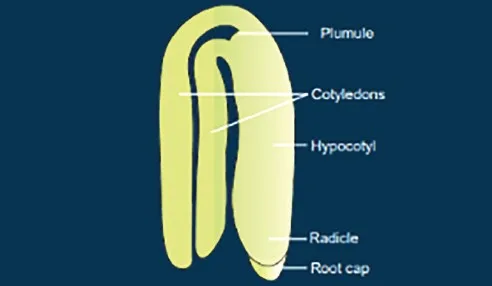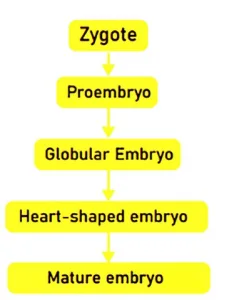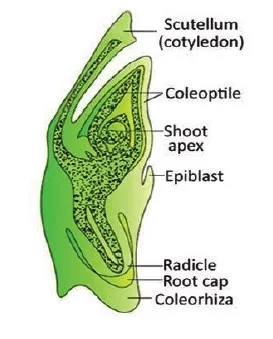
Embryo: An embryo is a developed form of a zygote formed when male and female gametes fuse. The zygote divides and differentiates into an embryo. In plants, the embryo develops following syngamy, the fusion of pollen grains (male gametes) and egg cells (female gametes). The embryo forms in plants at the micropylar end of the female gametophyte, or embryo sac. Triple fusion leads to the formation of endosperm, which nourishes the developing embryo. The following article describes the development of embryos in monocots and dicots for the NEET Exam .
What is Embryo Development in Plants?
Plant embryogenesis is the process by which a plant embryo develops after fertilising an ovule. This is an important plant life cycle stage; germination and dormancy follow. The zygote formed after fertilisation divides and changes into a mature embryo. A mature embryo is made up of five major parts: the hypocotyl, shoot apical meristem, root meristem, root cap, and cotyledons. Plant embryogenesis, unlike animal embryogenesis, produces an immature plant with no structures such as leaves, stems, or reproductive parts. Both plants and animals go through a phylotypic stage, which limits morphological diversification and allows them to evolve independently. Dicot and Monocot embryos continue to develop until the globular embryo stage. Following this stage, the two groups differ. This article covers the embryo's development in monocots and dicots, a key topic in the NEET Exam's chapter on sexual reproduction in flowering plants .Embryo Development in Dicots
Embryogenesis is the natural process of forming a seed in plants after fertilisation. It involves the development of two key structures: the plant embryo and the endosperm, which later become the seed. The zygote, formed from fertilisation, undergoes several cell divisions to form a mature embryo. This process establishes the basic cellular pattern for the plant's shoot-root body and primary tissue layers. However, the specific events described here only apply to eudicots, not monocots.
Flower – A Fascinating Organ of Angiosperms
Stages of Developement in Dicots
Embryogenesis can be divided into the following stages of development:- Two Cell Stage: After fertilisation, the zygote divides into a small apical and a large basal cell. These cells are different and give rise to different parts of the plant, establishing polarity in the embryo.
- Eight Cell Stage: The embryo now consists of eight cells, with distinct domains contributing to different parts of the plant, such as the shoot apical meristem, cotyledons, hypocotyl, and root apical meristem.
- Sixteen Cell Stage: Additional cell divisions occur, and the four domains become more defined. The protoderm, which forms the epidermis, is introduced during this stage.
- Globular Stage: The embryo becomes spherical or globular in shape. The ground meristem and procambium, which form the ground tissue and vascular tissue respectively, are initiated during this stage.
- Heart Stage: The cotyledons start to form and elongate, giving the embryo a heart-shaped appearance.
- Pro Embryo Stage: The cotyledons continue to grow, and parts of the suspensor complex are terminated to make space for the mature embryo.
- Maturation: The cells mature, and macromolecules required for germination and seedling growth are stored in the embryo.

Pre Fertilisation – Structures And Events
Embryo Development in Monocots
Monocotyledon embryos have only one cotyledon, known in the grass family as a scutellum. The scutellum is located laterally along the embryonic axis. A radical and root cap are enclosed in a sheath called coleorrhiza at the embryonal axis's lower end. The epicotyl portion of the embryonal axis extends above the scutellum attachment. The shoot apex and a few leaf primordia of the epicotyl are enclosed by the hollow foliar structure known as the coleoptile. Some monocots, such as Sagittaria sagittifolia, are studied for their embryo development. Dicot and monocot embryos develop similarly until the globular stage. After this stage, the difference between monocots and dicots becomes clear. Monocots have a single terminal cotyledon, while dicots have two cotyledons. Monocots have either no second cotyledon or one that is significantly smaller. The scutellum refers to the single terminal cotyledon. The reduced cotyledon is referred to as the epiblast.Sexual Reproduction in Flowering Plants MCQ
During embryo development, a transverse wall separates the basal cell into two cells. One of these cells divides into two, resulting in the formation of a suspensor and root cap. Another cell forms the rest of the root cap and a portion of the radical. The terminal cell has two perpendicular walls that form a quadrant structure, while periclinal cells are divided into outer and inner cells. Both groups of cells divide repeatedly, resulting in two zones.
Alternative Forms of Embryogenesis
Aside from plant embryogenesis, two other important processes occur during embryo development. It includes somatic embryogenesis and androgenesis.Somatic Embryogenesis
- Somatic embryos are made from plant cells that do not normally develop into embryos.
- They do not have a seed coat or an endosperm.
- This method clones plants, removes viruses, performs genetic transformations, grows plants from single cells (protoplasts), and produces synthetic seeds.
- Plant tissue cells grow into a callus, a mass of undifferentiated cells.
- Plant growth regulators in the culture medium facilitate callus formation and, eventually, embryos.
- The quantity of plant growth regulators required varies according to plant type.
- Somatic embryo development requires asymmetrical cell division, and the failure to form a specific cell (suspensor cell) does not result in the death of the embryo.
Androgenesis
- Androgenesis is when a mature plant embryo forms from an immature pollen grain.
- This usually happens under stressful conditions.
- The embryo develops from a single pollen grain that contains three cells.
- Androgenesis must occur during a specific type of microspore division.
- Androgenesis is impossible once the pollen grain's vegetative cells start producing starch and proteins.
- Androgenesis occurs in three stages: acquiring embryonic potential, initiating cell divisions, and pattern formation.
- After these phases, the rest of the process is like regular embryogenesis.
| NEET Exam Important Links | |
|---|---|
| NEET Biology Syllabus | NEET Biology Diagrams |
| NEET Biology MCQ | NEET Biology Chapter wise Weightage |
| NEET Biology Notes | NEET Previous Year Question papers |
Embryo FAQs
What are the four stages of embryo development in dicot plants?
In dicots, the zygote transforms into an embryo at the micropylar end. The zygote gives rise to the proembryo, which then develops into the globular stage, eventually forming a cordate or heart-shaped embryo. Further development of the heart-shaped embryo leads to the mature embryo stage.
Which type of embryo is present in monocots?
A monocotyledonous seed contains embryos with only one large cotyledon, the scutellum. Generally, the scutellum is shield-shaped and is located laterally towards the side of the embryo axis.
What is the difference between a monocot and a dicot embryo?
The primary distinction between monocotyledons and dicotyledons is that monocots have a single cotyledon in their embryos, whereas dicots have two cotyledons.
What is the eight-cell stage embryo in plants?
At the eight-cell stage, the proembryo divides into an upper tier of cells that give rise to the shoot and a lower tier of cells that give rise to the hypocotyl and embryonic root.
How is the embryo developed in plants?
The embryo is the developed form of a zygote that forms after the fertilisation of male and female gametes. An embryo is formed when the zygote divides and undergoes differentiation. In plants, the embryo forms after the process of syngamy occurs.
Talk to a counsellorHave doubts? Our support team will be happy to assist you!

Check out these Related Articles
Free Learning Resources
PW Books
Notes (Class 10-12)
PW Study Materials
Notes (Class 6-9)
Ncert Solutions
Govt Exams
Class 6th to 12th Online Courses
Govt Job Exams Courses
UPSC Coaching
Defence Exam Coaching
Gate Exam Coaching
Other Exams
Know about Physics Wallah
Physics Wallah is an Indian edtech platform that provides accessible & comprehensive learning experiences to students from Class 6th to postgraduate level. We also provide extensive NCERT solutions, sample paper, NEET, JEE Mains, BITSAT previous year papers & more such resources to students. Physics Wallah also caters to over 3.5 million registered students and over 78 lakh+ Youtube subscribers with 4.8 rating on its app.
We Stand Out because
We provide students with intensive courses with India’s qualified & experienced faculties & mentors. PW strives to make the learning experience comprehensive and accessible for students of all sections of society. We believe in empowering every single student who couldn't dream of a good career in engineering and medical field earlier.
Our Key Focus Areas
Physics Wallah's main focus is to make the learning experience as economical as possible for all students. With our affordable courses like Lakshya, Udaan and Arjuna and many others, we have been able to provide a platform for lakhs of aspirants. From providing Chemistry, Maths, Physics formula to giving e-books of eminent authors like RD Sharma, RS Aggarwal and Lakhmir Singh, PW focuses on every single student's need for preparation.
What Makes Us Different
Physics Wallah strives to develop a comprehensive pedagogical structure for students, where they get a state-of-the-art learning experience with study material and resources. Apart from catering students preparing for JEE Mains and NEET, PW also provides study material for each state board like Uttar Pradesh, Bihar, and others
Copyright © 2025 Physicswallah Limited All rights reserved.
Get App









